Tetrapod fauna
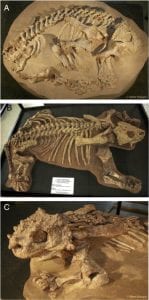 The fossil amphibians and reptiles from the main Kotel’nich section are well known, including the plant-eating pareiasaur Deltavjatia (Hartmann-Weinberg, 1937; V’yushkov, 1953; Ivakhnenko, 1987; Lee, 2000; Kordikova and Khlyupin, 2001) the galeopid anomodont Suminia (Ivakhnenko, 1994; Rybczinski, 2000; Fröbisch and Reisz, 2009), and the gorgonopsian Viatkogorgon (Tatarinov, 2004a), as well as the small insect-eating parareptile Emeroleter (Ivakhnenko, 1997), and small carnivorous theriodonts (Tatarinov, 1968, 1995a, b, 1997, 1999a, b, 2000, 2004a, b).
The fossil amphibians and reptiles from the main Kotel’nich section are well known, including the plant-eating pareiasaur Deltavjatia (Hartmann-Weinberg, 1937; V’yushkov, 1953; Ivakhnenko, 1987; Lee, 2000; Kordikova and Khlyupin, 2001) the galeopid anomodont Suminia (Ivakhnenko, 1994; Rybczinski, 2000; Fröbisch and Reisz, 2009), and the gorgonopsian Viatkogorgon (Tatarinov, 2004a), as well as the small insect-eating parareptile Emeroleter (Ivakhnenko, 1997), and small carnivorous theriodonts (Tatarinov, 1968, 1995a, b, 1997, 1999a, b, 2000, 2004a, b).
Fig. 1. Photographs of prepared specimens of Deltavjatia vjatkensis, as preserved: (A) skeleton lying on its side, missing part of its tail, KPM 290; (B) skeleton lying belly-down and with the limbs outstretched, KPM 232; (C) close-up of skeleton, with head and forelimbs raised, KPM 289. Photographs by Al’bert Yu. Khlyupin.
The dicynodont Australobarbarus (Kurkin, 2000) and two pareiasaurs found in 2009, possibly also Deltavjatia, come from the separate Port Kotel’nich locality, located 10 km to the north, on the river bank at Kotel’nich town. Further, the fish-eating chroniosuchian Chroniosaurus (Golubev, 1998, 2000), the basal biarmosuchian Proburnetia (Tatarinov, 1968), and the pareiasaur Proelginia permiana (= Scutosaurus karpinskii) are known from the younger Sokol’ya Gora locality.
The fauna has always been recognised as stratigraphically significant. Ivakhnenko (1987, 1992) established the ‘Kotel’nich Subcomplex’ (Kotel’nichskii Subkompleks) as the lowest of three faunal assemblages within the Sokolki Complex that spanned the Severodvinian and lower Vyatkian gorizonts, as part of the traditional tetrapod-based division of the Russian Permo-Triassic red beds (Efremov, 1939, 1941; Lucas, 2004, 2006).
Flora and non-tetrapod fauna
The Kotel’nich red beds have produced plant fossils in addition to the famous tetrapods. V’yushkov (1953) and Ignat’ev (1963) mentioned the occurrence of plants, and Goman’kov (1997) provided a detailed study, reporting a detrital macroplant assemblage from the Chizhi Member channels referable to the Tatarina flora, with the conifers Phylladoderma and Geinitzia, the peltaspermalian pteridosperms (seed ferns) Tatarina, Pursongia, and Permotheca, and the horsetails Paracalamites and Phyllotheca, as well as miospores of the same plants that may be used in biostratigraphy. These same organic-rich sandstone units of the Chizhi Member have produced further fossils, including ostracod tests, fish scales, and isolated tetrapod bones (Tverdokhlebov and Shminke, 1990; Goman’kov, 1997) from the bottom of these detrital channel units.
The bestiary
These amazing drawings of the Kotel’nich tetrapods are by Al’bert Khlyupin, and they are presented at the website of the Vyatka Palaeontological Museum.
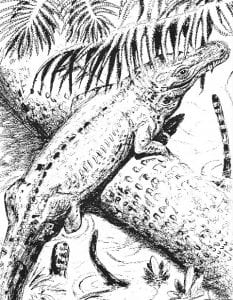 Water-living temnospondyl |
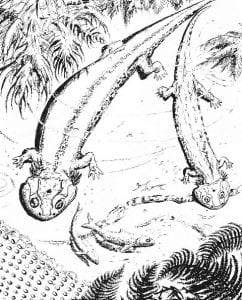 Water-living temnospondyl Dvinosaurus |
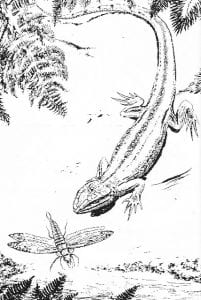 Small parareptile Nycteroleter |
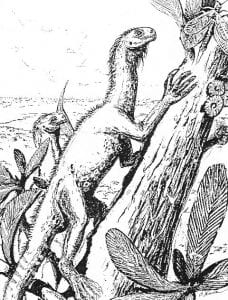 Anomodont Suminia |
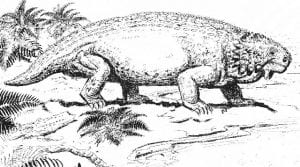 Pareiasaur Deltavjatia |
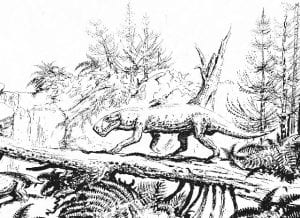 Gorgonopsian Vyatkagorgon |
References
- Golubev, V.K. 2000. Permian and Triassic chronosuchians and biostratigraphy of the upper Tatarian deposits of Eastern Europe by tetrapods. Trudy Paleontologischeskogo Instituta, 276, 1-176. Download English translation.
- Goman’kov, A.V. 1997. Permian (Tatarian) flora of the Kotel’nich vertebrate locality (Kirov Region). Stratigrafiya, Geologicheskaya Korrelyatsiya 5 (4), 3-12. Download English translation.
- Hartmann-Weinberg, A.P. 1937. Pareiasauriden als Leitfossilien. Problemy Paleontologii 2, 649-712.
- Ivakhnenko, M.F. 1987. The Permian parareptiles of the USSR. Trudy Paleontologicheskogo Instituta AN SSSR 223, 1-160 in Russian.
- Ignat’ev, V. I. 1963. Tatarian Stage of Central and Eastern Regions of the Russian Platform. Part II: Facies, Palaeogeography. Izdatel’stvo Kazanskogo Universiteta, Kazan’. Download English translation.
- Tverdokhlebov, V.P. & Shminke, L.N. 1990. Aeolian deposits of the Tatatian Stage in the Vyatka River Basin. Doklady Akademii Nauk SSSR 315 (4), 934-936. Download English translation.
- V’yushkov, B.P. 1953. Locality for pareiasaurs on the Vyatka below Kotel’nich. Byulleten’ Moskovskogo Obshchestva Ispytatelei Prirody, Otdel Geologicheskii 28, 49-56, in Russian.

